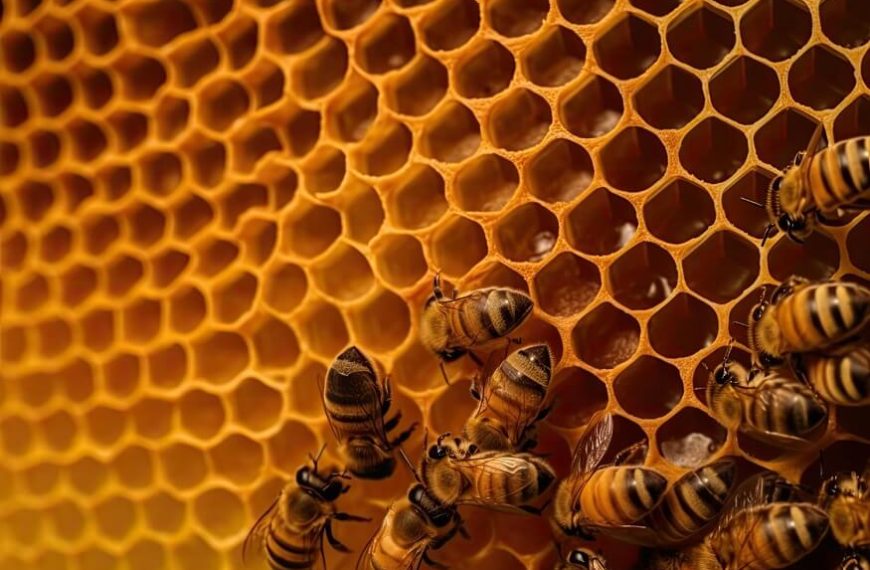Have you ever wondered where that delicious, golden honey on your pancakes comes from? Without honey, some of the sweetest treats we enjoy today would not be possible. Today we are going to take a journey into the buzzing world of bees and uncover how they make honey. Buckle up and get ready to be amazed by these incredible little insects!
But first, what exactly is honey?
What honey is made up of extends far beyond its role as a delicious treat; it unveils itself as a natural wonder! This thick, sweet liquid is a result of bees’ remarkable alchemy, transforming flower nectar into a substance that transcends the ordinary. Within the composition of honey lies a harmonious blend of sugars, predominantly glucose and fructose, accompanied by a hint of water. But the intrigue doesn’t end there. The intricate concoction also houses a wealth of vitamins, minerals and antioxidants that contribute to its extensive health benefits. The allure of honey goes beyond its sweet flavor; it embodies the wholesome goodness derived from the laborious efforts of our busy little workers and the essence of blooming flowers.
Why do bees make honey?
You might be wondering ‘Why do bees make honey at all?’ Bees are truly remarkable creatures, and the reason they make honey is all about survival. In the world of bees, honey is their lifeline. During the warmer months, bees venture out of their hives to visit a variety of flowers, collecting nectar along the way. This nectar is essentially sugary water filled with energy, like the perfect bee energy drink. However, it can be pretty runny and would spoil quickly. To make it last, bees devised a clever plan. Back at the hive, they transform the nectar into honey. They do this by passing the nectar from bee to bee, adding special enzymes and reducing its moisture content. This amazing process creates honey: a thick, sweet and long-lasting energy source. So, in a nutshell, bees make honey to ensure they have enough food to keep their colony strong and thriving, even during the colder months when flowers are scarce. It’s a real testament to the incredible teamwork and adaptability of these tiny yet industrious insects.
Types of honey
Just like a rainbow has many colors, honey comes in a variety of types, each with its unique flavor and characteristics. Each type of honey has its own character and charm, making it a delightful experience to explore the different flavors and discover which one you like best.
Let’s take a closer look at some of the most popular types of honey:
- Clover Honey:
- Wildflower Honey:
- Orange Blossom Honey:
- Lavender Honey:
- Acacia Honey:
- Eucalyptus Honey:
- Manuka Honey:
- Buckwheat Honey:
- Heather Honey:
- Sage Honey:
This is one of the most common types of honey. Bees collect nectar from clover flowers, which results in a mild sweet, and light-colored honey. It’s the kind of honey you often find in those cute bear-shaped bottles.
As the name suggests, wildflower honey is made from the nectar of various wildflowers. This gives it a diverse and complex flavor, reflecting the mixed bouquet of flowers the bees visit. It’s like a taste of nature’s wild side.
Bees that visit orange tree blossoms create this honey. It has a lovely citrusy aroma and a delicate slightly fruity flavor. It’s perfect for drizzling on pancakes or adding a touch of gold to your tea.
Lavender fields aren’t just beautiful; they are a bee’s paradise. Lavender honey has a distinct floral flavor and a pale golden color. It is a popular pick for people who appreciate a touch of elegance in their honey.
Acacia trees produce a nectar that bees turn into a honey known for its mild, light and almost transparent appearance. It has a clean, delicate taste and is a great choice for sweetening your morning cup of tea without overwhelming the overall flavor of the beverage.
Eucalyptus trees are often associated with koala bears, but they’re also a great source of honey. Eucalyptus honey has a strong, distinct taste with a hint of menthol, making it a popular choice for soothing sore throats.
Hailing from the native Manuka shrub in New Zealand and Australia, this honey is known for its medicinal properties. It has a rich, earthy flavor and is prized for its potential health benefits. Manuka honey is often used as a natural remedy for various ailments.
Buckwheat honey has a deep, dark color and robust, almost molasses-like taste. It’s perfect for adding a rich, bold sweetness to your dishes and drinks.
Bees that forage on heather plants produce this unique honey. It has a strong, slightly woody flavor and a darker color. It is considered an acquired taste but beloved by those who appreciate its distinctiveness.
Sage plants are famous for their fragrant leaves and bees that visit sage flowers create honey with a light and delicate herbal flavor. It’s a great choice for tea and baked goods.
Why do we eat honey?
Honey, often referred to as ‘liquid gold,’ is not just a natural sweetener; it is also packed with numerous benefits for human consumption. Here are wonderful ways it can contribute to our well-being:
- Honey contains a wide range of vitamins and minerals, including vitamin C, B vitamins, calcium, magnesium, potassium and iron.
- It also provides a quick and sustained energy boost, making it a fantastic option for a pre-workout snack or to combat that afternoon slump.
- Natural honey is rich in antioxidants, which help protect your body from free radicals and oxidative stress.
- It possesses antibacterial properties and creates a protective barrier over wounds, helping to prevent infection.
- When you have a sore throat or cough, a spoonful of honey can be a soothing and natural remedy.
- Honey has prebiotic properties, which means it can support the growth and activity of beneficial gut bacteria.
- When applied topically, honey can hydrate and nourish your skin, leaving it soft and glowing.
- Unlike refined sugars, honey’s natural sweetness can satisfy your sweet tooth with less volume, and its unique composition can help regulate blood sugar levels.
- Honey can positively affect your mood and reduce anxiety. It contains tryptophan, an amino acid that helps the body produce serotonin, a neurotransmitter associated with mood and well-being.
How bees make honey
Now, the most exciting part: a step-by-step account of how bees make honey! It’s like a magical process that involves teamwork, determination and a never-give-up attitude!
- Collecting Nectar:
- Transforming Nectar:
- Drying the Nectar:
- Storing the Honey:
- Feeding the Colony:
Worker bees, who are all female, venture out of the hive to find flowers. They use their long tongues to suck up the nectar from the flowers. Then, they store the nectar in their special ‘honey stomach.’
When a worker bee returns to the hive, she passes the nectar to another worker bee. This bee adds enzymes to the nectar, which starts to break down the sugars and transform it into natural honey.
To make the nectar thicker and less watery, bees fan it with their wings. They also remove excess moisture by repeatedly swallowing and regurgitating the nectar.
Once the nectar turns into honey, bees seal it inside a honeycomb cell with beeswax. This keeps it fresh and safe until it’s time to be eaten.
Honey isn’t just for humans; it’s the main food source for the entire bee colony. During the cold winter months when flowers are scarce, bees munch on their stored natural honey to stay warm and alive.
Did You Know?
Here are some interesting facts about honey production:
- A single honey bee produces only about 1/12th of a teaspoon of honey in its lifetime.
- Bees collect nectar from flowers, which is then transformed into honey through a process involving regurgitation and evaporation.
- Teamwork is crucial in honey production, with many bees contributing to the creation of a single jar of honey.
- The flavor and color of honey are influenced by the types of flowers visited by bees, resulting in a diverse range of honey varieties.
- Beekeepers play a vital role in honey production by managing hives and ensuring bees have access to a variety of flowers.
- Honey’s preservation properties are remarkable, with evidence of its consumption dating back to ancient civilizations, and honey found in ancient Egyptian tombs remaining edible today.
From the diverse types of honey, each with its unique flavor, to the myriad ways it contributes to our well-being, honey is a true wonder of the natural world. It’s not just a delicious addition to our meals and snacks, but also a source of energy, healing and comfort. Whether we drizzle it on our morning pancakes, add a spoonful to our tea or use it to soothe a sore throat, honey plays a significant role in our lives. But beyond its delectable taste and myriad uses, honey is a reminder of the delicate balance of the ecosystem and the crucial role bees play in maintaining it. Bees, as nature’s little gardeners, are vital to our food chain and the health of our planet.














